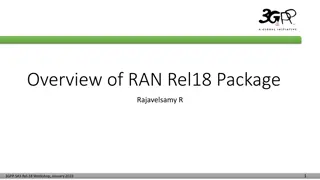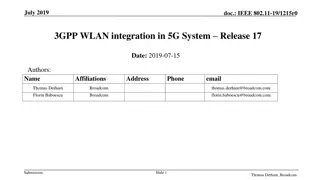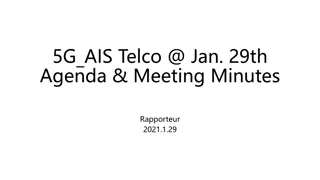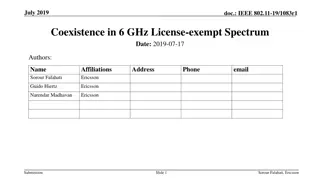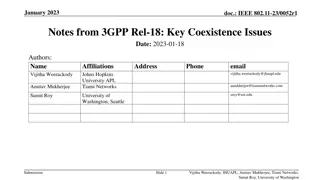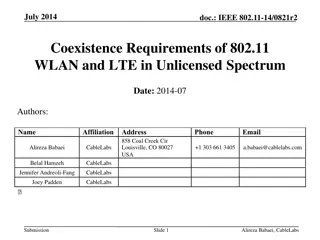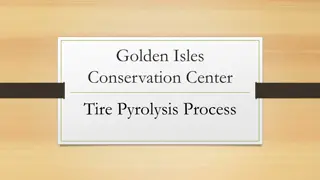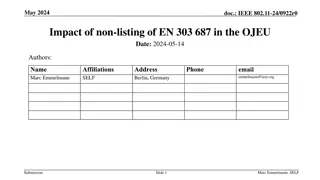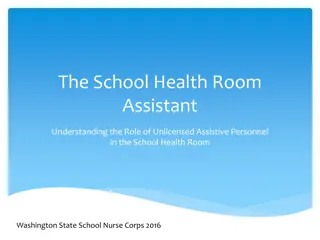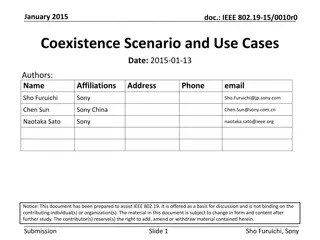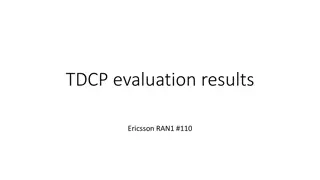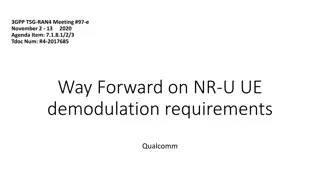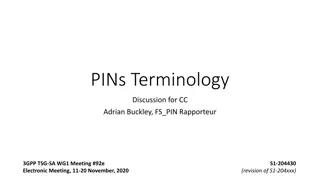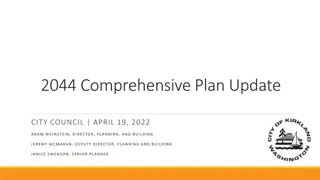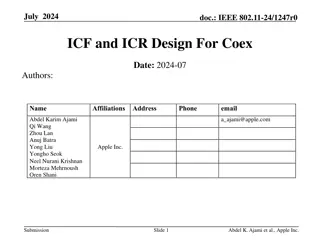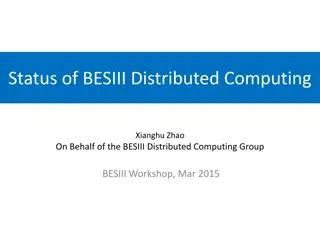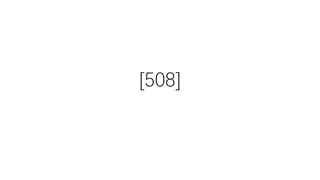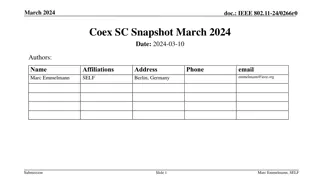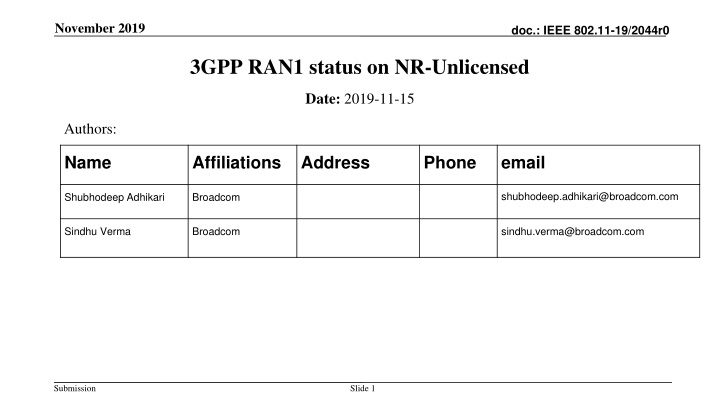
Update on 3GPP RAN1 Meeting - NR-Unlicensed Standardization Progress
This presentation provides insights from the 3GPP RAN1 meeting regarding the standardization of NR-Unlicensed, focusing on fair coexistence with IEEE 802.11. It covers topics such as gNB sharing channel occupancy, contention window adaptation mechanisms in NR-U, and multi-carrier LBT. The status of CW adaptation mechanisms and unresolved decisions are also discussed.
Download Presentation

Please find below an Image/Link to download the presentation.
The content on the website is provided AS IS for your information and personal use only. It may not be sold, licensed, or shared on other websites without obtaining consent from the author. If you encounter any issues during the download, it is possible that the publisher has removed the file from their server.
You are allowed to download the files provided on this website for personal or commercial use, subject to the condition that they are used lawfully. All files are the property of their respective owners.
The content on the website is provided AS IS for your information and personal use only. It may not be sold, licensed, or shared on other websites without obtaining consent from the author.
E N D
Presentation Transcript
November 2019 doc.: IEEE 802.11-19/2044r0 3GPP RAN1 status on NR-Unlicensed Date: 2019-11-15 Authors: Name Affiliations Address Phone email shubhodeep.adhikari@broadcom.com Shubhodeep Adhikari Broadcom Sindhu Verma Broadcom sindhu.verma@broadcom.com Submission Slide 1
November 2019 doc.: IEEE 802.11-19/2044r0 Outline This presentation provides a short update from the 3GPP RAN1 meeting RAN1#98-Bis between 14/Oct 20/Oct on the standardization of NR-Unlicensed, with a focus on fair coexistence with 802.11. The presentation discusses status of the following topics: 1. 2. 3. gNB sharing a Channel Occupancy won by a UE. Contention Window adaptation mechanisms in NR-U LBT for a 16us gap after a DL transmission and before a UL transmission in a gNB-acquired COT in NR-U. Multi-carrier LBT 4. Submission Slide 2
November 2019 doc.: IEEE 802.11-19/2044r0 gNB sharing a Channel Occupancy won by a UE Agreement: Sharing of a UE-initiated channel occupancy (either CG-PUSCH or scheduled UL) with gNB is supported, such that the gNB is allowed to transmit control/broadcast signals/channels for any UEs as long as the transmission contains transmissions for the UE that initiated the channel occupancy and/or DL signals/channels (PDSCH, PDCCH, reference signals) meant for the UE that initiated the channel occupancy. The ED threshold that the UE applies when initiating a channel occupancy to be shared with the gNB is configured by gNB (RRC signaling) if ED threshold that the UE applies when initiating a channel occupancy to be shared with the gNB is not configured, the transmission of the gNB in UE initiated COT may include only control/broadcast signals/channels transmissions of up to 2/4/8 OFDM symbols in duration for 15/30/60 kHz SCS When absence of WiFi cannot be assumed based on e.g. regulation, the ED threshold that the gNB configures to the UE to apply when initiating the channel occupancy is determined based on the max gNB TX power Cat. 2 LBT can be used (for gaps of 16us and 25us). Cat. 1 LBT can be used under the following conditions. Gap duration <= 16us For the transmission of the gNB after the first switch between the UE and the gNB if the gNB transmission contains only control/broadcast signals/channels For the transmission of the gNB after the first switch between the UE and the gNB if the gNB transmission has a duration below X ms (X >= 0). FFS: X FFS: For transmissions after the second and subsequent switches between UE and gNB Submission Slide 3
November 2019 doc.: IEEE 802.11-19/2044r0 Contention Window adaptation mechanisms in NR-U CW adaptation mechanisms have been partially agreed The principle of the CW being adapted based on errors at the start of the transmission/COT has been approximately adhered to. There has been no decision yet on the following: % of errors among data transmissions that will lead to doubling the CW. Unit of transmission (say Code block or Transport block) that will be considered for error determination. Delayed feedback Submission Slide 4
November 2019 doc.: IEEE 802.11-19/2044r0 LBT in the 16us gap after DL transmission and before UL transmission in a gNB-acquired COT in NR-U In 11ax, UL transmissions after a trigger and within 16us of the trigger, need mandatory channel sensing (via both energy detection as well as preamble detection) in case the transmissions are longer than a specified duration. Such sensing is a good practice as it avoids collisions from nodes that are visible to the UL/client but not to the DL/AP. The goal has been to put a similar principle for NR-U. However, as there has been no consensus on a common preamble, NR-U at least for now will restrict itself to energy detection only in the gap between the DL and UL transmission. Note: Energy detection involves sensing the channel for not less than 4us. For NR-U, there has been no agreement so far on the number of such 4us sensing intervals within the 16us gap. Many companies in 3GPP want only one such sensing interval in 16us. However, 11ax has to do such sensing twice in order to meet the standards requirements. Sensing twice is a more robust procedure to detect hidden nodes, in light of slot misalignment between NR-U and Wi- Fi and the absence of an additional layer of preamble detection. Note that absence of preamble detection also leads to sensing misalignment between NR-U and Wi-Fi which reduces the effectiveness of energy detection Submission Slide 5
November 2019 doc.: IEEE 802.11-19/2044r0 Multi-carrier LBT LAA multi-carrier LBT Type B does not adhere to EN 301 893. Since LAA is the baseline for NR-U, there is expectation in RAN1 that NR-U follow the same multi-carrier scheme, even if it violates EN 301 893. This is expected to be discussed in the upcoming RAN1 meeting (18/Nov 22/Nov) in Reno. Submission Slide 6
November 2019 doc.: IEEE 802.11-19/2044r0 Appendix Submission Slide 7
November 2019 doc.: IEEE 802.11-19/2044r0 Agreements made in RAN1#98 on CW adaptation (1) Agreement: For a gNB initiated channel occupancy the reference duration for CWS adjustment is defined as follows. For a CO with unicast PDSCH(s) and for each set of LBT bandwidths for which a single contention window is maintained, the reference duration for CWS adjustment is from the beginning of the CO until the end of the first slot where at least one unicast PDSCH is transmitted over all the resources allocated for the PDSCH, or until the end of the first transmission burst by the gNB that contains unicast PDSCH(s) transmitted over all the resources allocated for the PDSCH, whichever occurs earlier. If the CO has a unicast PDSCH, but doesn t have any unicast PDSCH transmitted over all the resources allocated for that PDSCH, then, the duration of the first transmission burst by the gNB within the CO that contains unicast PDSCH(s) is the reference duration for CWS adjustment. Agreement: For a UE initiated channel occupancy the reference duration for CWS adjustment is defined as follows. For a CO with PUSCH(s) and for each set of LBT bandwidths for which a single contention window is maintained, the reference duration for CWS adjustment is from the beginning of the CO until the end of the first slot where at least one PUSCH is transmitted over all the resources allocated for the PUSCH, or until the end of the first transmission burst by the UE that contains PUSCH(s) transmitted over all the resources allocated for the PUSCH, whichever occurs earlier. If the CO has a PUSCH, but doesn t have any PUSCH transmitted over all the resources allocated for that PUSCH, then, the duration of the first transmission burst by the UE within the CO that contains PUSCH(s) is the reference duration for CWS adjustment. Submission Slide 8
November 2019 doc.: IEEE 802.11-19/2044r0 Agreements made in RAN1#98 on CW adaptation (2) Agreement: For a gNB initiated channel occupancy, for a DL burst without unicast PDSCH and with one or multiple UL grants, and for each set of LBT bandwidths for which a single contention window is maintained, CWS adjustment is based on the success or failure (FFS: CB, CBG, or TB) of reception of PUSCH transmissions in the granted resources FFS: Details of CWS adjustment based on the reception of a successful transmission FFS: Handling of PUCCH/PRACH/SRS and PUSCH without UL-SCH Submission Slide 9


